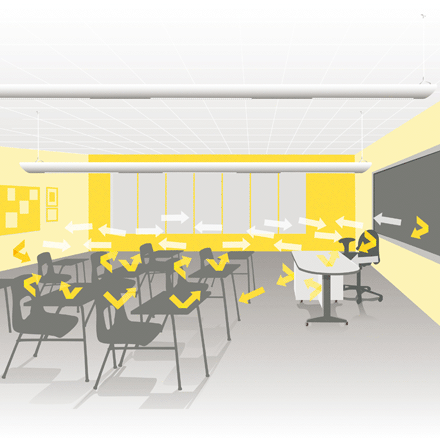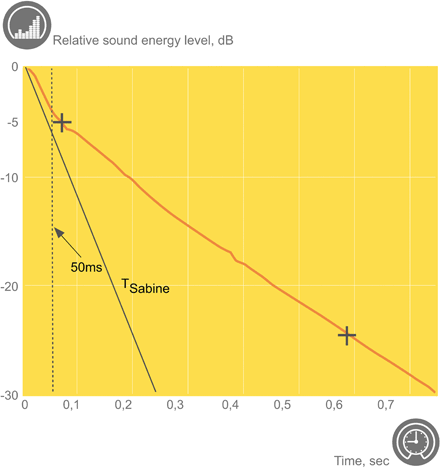Rooms with absorbent ceilings
Sound field at steady-state in a room with absorbent ceiling and sound scattering objects
Rooms with absorbent ceilings are more common. In these rooms, the reverberation time does not only depend on absorption. The room’s sound-scattering furnishings, how the absorbers are placed and the shape of the room also play an important role. However, the sound level will mainly depend on the room’s total absorption. The more absorption the room is given, the lower the sound level will be.
In rooms with absorbent ceilings, we distinguish between two situations that we call “steady-state” and “reverberation”. In the case of steady-state, a sound source emits sound continuously, with the room thus having a constant level of sound. Even in rooms with absorbent ceilings, the sound is more or less diffuse at steady state. Consequently, we can determine sound level reduction in the same way as for a reverberant "hard" room.

|
White arrow: Grazing waves |
Yellow arrow: Non-grazing waves (diffuse field) |
Sound field during sound decay in a room with absorbent ceiling
In the case of reverberation, the situation is somewhat more complex than for steady-state.
When the sound source is turned off, the sound waves that hit the ceiling absorber will disappear much more quickly than the sound waves that propagate almost parallel to the ceiling and floor. This is of course related to the fact that much of the sound energy that reaches the ceiling is absorbed.
If there are no furnishings in the room, and if the walls and floor are plane surfaces with a low level of absorption, the reverberation time will be determined by the ceiling absorption for grazing incidence and the walls’ and floor’s absorption. Grazing incidence means here that the sound waves propagates almost parallel to the ceiling and floor. The ceiling’s absorption factor for grazing incidence is often significantly less than the absorption factor that is normally stated. The reverberation time here will be much longer than could be expected from a calculation using Sabine's formula.

|
White arrow: Grazing waves |
Yellow arrow: Non-grazing waves |
When the room is furnished, the grazing sound field will be split up and some of the horizontal energy will be transmitted up into the ceiling absorber. The effect of this sound scattering is that the reverberation time will be shorter. In rooms where the main absorption is in the ceiling, the effect of non-absorbent furnishings will therefore also be expressed as increased absorption.
Calculating the reverberation time
To calculate the reverberation time in a room with an absorbent ceiling, the following must be taken into consideration:
1. Absorption factor for grazing incidence for the ceiling absorber.
2. The absorption effect of sound-scattering and sound-absorbing furnishings
3. Absorption factor for walls and floor
4. Air absorption

The reverberation curve in a classroom for
a) empty room
b) a + an absorbent ceiling
c) b + shelves, cupboards and furnishings along the walls
d) c + pupil stations, each consisting of a chair and small table, distributed across the floor
Reverberation curve in a room with an absorbent ceiling.

The room only contains a small number of sound-scattering objects. The curve shows an uneven course, with the sound energy diminishing quickly in the early section of the curve and then slowing down in the later part. In the early section, the gradient of the curve corresponds quite well with a curve estimated using Sabine's formula, indicating that we have a diffuse sound field exactly at the point when we turn off the sound source, i.e. in the case of steady-state. When evaluating T20 and T30 it is, however, the later section of the curve that is evaluated and that corresponds to the grazing field.
Reflections that arrive within 50 ms after the direct sound contribute to speech intelligibility and are thus regarded as beneficial reflections. Sound that arrives later can cause diminished speech intelligibility. Since T20 and T30 are not evaluated until after the sound level has fallen by 5 dB, the effect of early reflections is often not included in these descriptors.
By only evaluating the reverberation time (T20, T30), acoustic information that is important to the subjective experience is missed. Sound level and early reflections, in this respect, are significant. These components are not included in the reverberation time. It is therefore very important to supplement the reverberation time with other room acoustic descriptors (G, C50, STI) linked to these aspects in particular.
These descriptors can differ from room to room although the reverberation times are the same, and better reflect the subjective difference that is perceived.
